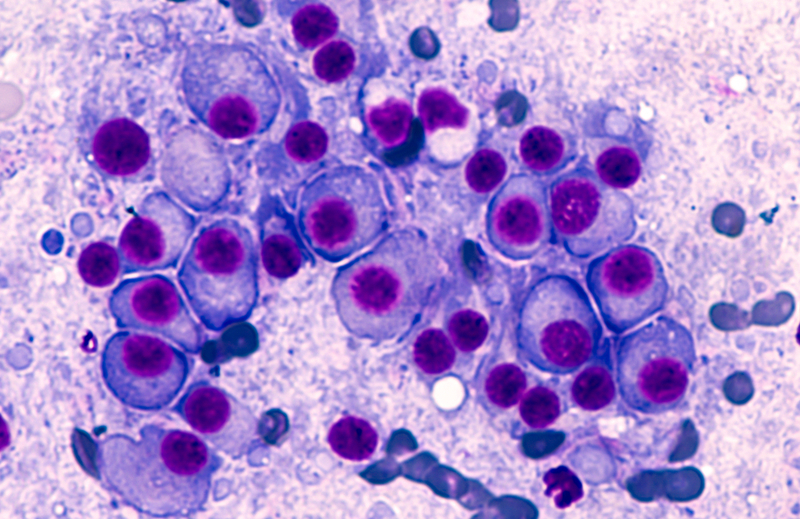BCMA-targeted immunotherapy can lead to durable responses in multiple myeloma: The Lancet
MedicalXpress Breaking News-and-Events Dec 19, 2019
An experimental, off-the-shelf immunotherapy that combines a targeted antibody and chemotherapy can lead to potentially durable responses in multiple myeloma patients whose disease has relapsed or is resistant to other standard therapies.

A multi-center, international trial evaluated the drug, belantamab mafodotin, and found almost a third of patients whose disease had returned after other therapies achieved a partial response or better when treated with this therapy, which targets the B-cell maturation antigen (BCMA). Data from 196 patients on the trial, called DREAMM-2, have been submitted to the US Food and Drug Administration for consideration for approval. The findings were published in Lancet Oncology today.
"Our data show this therapy can make a difference for patients with multiple myeloma who have exhausted all other options, including other antibody therapies," said the study's senior author Adam D. Cohen, MD, an assistant professor of Hematology-Oncology in the Perelman School of Medicine at the University of Pennsylvania and a member of Penn's Abramson Cancer Center. The study's first author is Sagar Lonial MD, FACP, chief medical officer of the Winship Cancer Institute of Emory University.
Multiple myeloma is a cancer of plasma cells, which build up in the bone marrow and crowd out healthy blood cells. It can also cause painful bone lesions, kidney damage, and recurrent infections. The American Cancer Society projects there were about 32,000 new cases in the United States in 2019, and the prognosis for patients whose disease has relapsed or is refractory (r/r) is poor. Patients enrolled in this trial were required to have disease that had relapsed or was refractory to a proteasome inhibitor, immunomodulatory drug (IMiD), and anti-CD38 antibody, a particularly difficult group to treat.
BCMA is a receptor on the surface of multiple myeloma cells that helps the cancer grow and survive. It is rarely expressed on healthy B cells, making it a promising target for therapy. Belantamab mafodotin is an experimental antibody-drug conjugate that consists of an antibody to target BCMA that is linked to a potent chemotherapy drug called MMAF. After binding to BCMA, belantamab mafadotin is internalized into the myeloma cell and then releases the MMAF, leading to highly targeted killing of the myeloma within the bone marrow while limiting systemic chemotherapy side effects. Belantamab mafadotin can also attract surrounding immune cells to attack the myeloma cells through a mechanism called antibody-dependent cellular cytotoxicity (ADCC). Patients receive an outpatient infusion every 3 weeks.
This phase 2 trial involved 58 centers in eight countries. Between June 2018 and January 2019, 196 patients were treated with either a low dose or high dose of the drug. In the low dose treatment group, 31% of patients (30 out of 97) achieved an overall response—meaning the treatment lowered the amount of cancer in their bodies. Of that group, 60% (18 patients) had a very good partial response or better—meaning the myeloma levels were reduced by 90% or more compared to before starting treatment. For the higher dose group, 34% (34 out of 99) achieved an overall response, with 59% of those (20 patients) achieving a very good partial response or better. Responses were achieved quickly, after a median of 1.4 months of treatment. With a follow up of 6.3 months for the low dose cohort and 6.9 months for the high dose cohort, the duration of response was not reached in either group. The median progression-free survival was 2.9 months and 4.9 months respectively, though it was not reached in patients who responded.
"These data build off the phase 1 trial that showed patient responses improved over time and contributed to prolonged progression free survival," Cohen said. "Since this study did not reach the median duration of response, we anticipate that further follow-up on these patients will confirm these responses can be durable."
Eight percent (8 out of 97) and 10% (10 out of 99) of patients in the low and high dose cohorts, respectively, had to stop treatment due to side effects. The most common patient-reported side effects included nausea (in 24% of low-dose and 32% of high-dose patients), fatigue (16% and 26%, respectively), blurred vision (22% and 30%, respectively), and dry eye (14% and 23%, respectively), with the majority of side effects being mild to moderate in severity. Microscopic changes to the lining of the cornea (the outer clear covering over the eye) were noted on eye examination in 71% of low dose and 75% of high dose patients, and were an expected side effect of the drug. While the effects are reversible, Cohen said patients on this trial needed to be co-managed with eye specialists so they could receive frequent eye exams and symptom management. Other side effects included thrombocytopenia, or low platelet count in the blood, which was reported in 35% of low dose patients and 59% of high dose patients.
"Overall, the side effects are manageable with appropriate supportive care, and the fact that this treatment can be given once every three weeks as an outpatient infusion means this could be a convenient and beneficial therapy for multiple myeloma patients," Cohen said. He notes that additional research is already underway to evaluate belantamab mafodotin in combination with other treatments.
-
Exclusive Write-ups & Webinars by KOLs
-
Daily Quiz by specialty
-
Paid Market Research Surveys
-
Case discussions, News & Journals' summaries